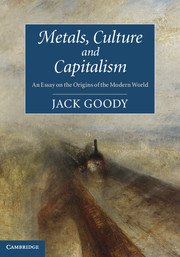Appendix 1 - The metallurgy of iron
Published online by Cambridge University Press: 05 June 2014
Summary
There are two main products in iron, wrought and cast. The former requires a lower temperature, the latter a higher one to make liquid iron, from which the slag floats off, and which can be cast to the required shape. Wrought iron has to be hammered into shape by a smith.
In a blast furnace, if the phosphorus content of the iron is low, as from ‘siliceous’ iron oxides (e.g. Cumbrian haematite), treatment of the iron produced can be in a reverberatory hearth or converter vessel with a siliceous lining and slag produced, progressively lowering the carbon content to the required level, with silicon and manganese being removed to an acid slag. Using a ‘basic’ (calcareous) vessel lining or hearth, a ‘basic’ slag high in lime can be produced and this can remove phosphorus.
Cast iron can be grey or white, depending on the form of the carbon that has been rejected from solution during solidification. In grey cast iron the carbon is present as graphite flakes, nodules or spheroids. Only in relatively recent years has control of graphite form by melt inoculation been possible to give the tougher form where graphite spheroids or nodules are produced rather than the flakes, to give a much tougher product, ‘SG’ iron.
- Type
- Chapter
- Information
- Metals, Culture and CapitalismAn Essay on the Origins of the Modern World, pp. 301 - 302Publisher: Cambridge University PressPrint publication year: 2012



